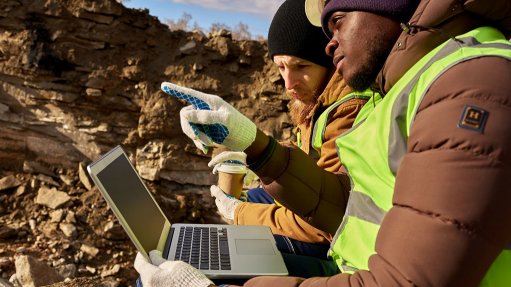
GRADE CONTROL The impact of having a more accurate grade control model is a better understanding of the variation in grade and geology at certain depths
Grade control is an important part of any mining operation, and software company Seequent technical services manager Kathryn Gall says Seequent’s key products, such as Leapfrog Geo, Leapfrog Edge and Seequent Central, provide value for grade control workflows.
“The impact of having a more accurate grade control model is a better understanding of the variation in grade and geology at certain depths. Without this, operations can become unprofitable.”
Therefore, setting up effective grade control workflows helps to minimise the differences between planned and actual ore production, and to reduce the risks of misdirected ore and unintentional dilution.
Moreover, a good understanding of the geological and structural controls on mineralisation is key to any successful mine operation and improving short- and long-term mine planning.
Products Implemented
Gold producer OceanaGold’s Waihi Martha underground project, in the north-west of the Bay of Plenty, on New Zealand’s North Island, has used Seequent solutions, including Leapfrog Geo, Leapfrog Edge and Seequent Central.
The Martha Underground project includes an area directly under the current Martha openpit and the south wall, and the Rex vein to the south of the pit. OceanaGold received consent to develop the Martha Underground in 2019. The project is expected to have a mine life of at least ten years.
Senior mine geologist Abe Whaanga and underground project geologist William Vigor-Brown are driving a significant portion of the geological effort for the Martha project.
“The geological effort is their daily work including logging data collected from the production drilling, sampling and mapping the underground faces. Loading data into Leapfrog and to generate and then dynamically update the three-dimensional (3D) geological model,” says Gall.
Seequent technology is used for this project, consequently allowing for dynamic workflows and flexible data updates.
Whaanga explains that Leapfrog Edge provides reliable interim modelling, which enables the OceanaGold team to schedule and predict risk, while the Leapfrog Geo enables mines to easily configure all their data in one location, using powerful visualisation and advanced tools to assist in gaining deeper insights.
Consequently, the team can incorporate the data collected from the production drilling, sampling and mapping data into Leapfrog, as it is generated, to then dynamically update the 3D geological model, he adds.
Therefore, having up-to-date lithology and mineralisation models provides teams with an enhanced geological understanding.
Moreover, the speed at which data is incorporated is a huge benefit, says Whaanga, and using implicit modelling enables teams to have a virtual, continuous view of the site.
Leapfrog also allows for the creation of multiple model branches.
“I can generate ten models, try different things and have a look at the outliers, and I can examine nine different failures and pick the best one,” Whaanga enthuses.
By increasing scrutiny by using the products one can be a lot more conservative and accurate in decision-making, owing to a more accurate model of the geology and grade.
“The final model is, therefore, of a much higher quality because we’re satisfied that we’ve explored all the different avenues.”
Leapfrog’s implicit modelling also allows for sample data to be incorporated into the updated model in minutes, thereby creating rapid and dynamic updates.
Consequently, all available mine data can be used daily, leading to an enhanced geological understanding and, ultimately, to better ore and waste decisions.
Further, engineers of OceanaGold can create different scenarios about scheduling and planning using interim models.
“If we haven’t finished an underground development but we’ve completed three-quarters of it because we are waiting for sample data from the laboratory, the production engineer can start designing, based on the interim model.
“Once it is completed, the production engineer can validate the earlier part of the design and complete the last part using the sample data,” Vigor-Brown explains.
This enables the production engineer to release scope designs earlier and “get that little bit ahead of the schedule”, he adds.
The OceanaGold team can, therefore, confidently generate interim models that enable adjacent teams to run scenarios, even before a current drive is completed.
Once a 3D model is created using Leapfrog, this can be shared through Seequent Central, which enables teams to collaborate; comment; monitor daily production performance; communicate to miners, engineers and geologists involved in operational planning; and report back to management.
This model of information is particularly important for the mine engineer to create and design a mine plan that efficiently extracts ore.
By having a dynamically up-to-date model of the mineral resources and ore reserves, the team can be more agile in its mining approach.
When the OceanaGold team first adopted Seequent Central, it regarded it only as a control system for models but has since realised how integral it is to the way the team works.
“We don’t even store any of the backups of our projects anywhere else, so we only have very limited data on our file servers for delivering output wireframes and block models to the engineers and everything else just sits in Central.
“If we need to go back to anything to find out whether there are any errors, we just go back a few versions, download it, have a look, delete it and move on,” Whaanga explains.
Gall comments that, in a conventional grade control model, the approach is very step- orientated, with the data moving linearly and in bulk, but with Seequent’s solution, the workflow is immersive and reiterative.
“With implicit modelling integrated into the heart of the workflow, the Seequent products provide rapid and dynamic short-term model updates that can use all available data,” she concludes.